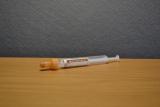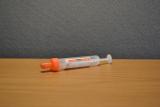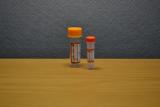Test Directory
Insulin
Containers - Adult

Brown Cap, Gel Clotted
|
Volume Range
1.0 ml
Additive per Container
None |

Orange Cap
|
Volume Range
1.0 ml
Additive per Container
Lithium-heparin |
Containers - Child

Orange Cap - Paediatric
|
Volume Range
0.40 ml
Additive per Container
Lithium-heparin |
Reference ranges
See General additional information
Laboratory Site
WGH
Crewe Road South
Edinburgh
EH4 2XU
Edinburgh
EH4 2XU
Telephone (Biochemistry): 0131 537 1910/1
Transport arrangements
Ice not required for transport, but blood must be separated and serum frozen within 4 h of collection.
Special instructions for collection
Send separate tube (yellow cap) for simultaneous glucose measurement. Avoid haemolysis.
Anticipated turnaround
7 days
General additional information
Interpretation of insulin results
A reference range for insulin is not provided because in most circumstances when insulin is requested it is not useful to compare the result with the range found in a normal healthy population.
Investigation of hypoglycaemia
Glucose and insulin should be measured during hypoglycaemia (Whipple’s triad should be met: symptoms, signs, or both consistent with hypoglycemia, a low plasma glucose concentration, and resolution of those symptoms or signs after the plasma glucose concentration is raised). C-peptide assists in the further differential diagnosis. Low insulin and C-peptide results (typically <14pmol/L & <50pmol/L, respectively) reflect the normal physiological response to hypoglycaemia and are normally associated with raised free fatty acid and β-hydroxybutyrate results. A measurable insulin and C-peptide in the face of hypoglycaemia suggests hyperinsulinism, and free fatty acids and β-hydroxybutyrate will not be raised. A measurable insulin paired with a low C-peptide suggests the presence of insulin from an exogenous source. The Abbott Architect method has been shown to cross-react with commonly prescribed insulin preparations (Actrapid, Humulin S, Insulatard, Humulin I, Humulin M3, NovoRapid, Apidra, Humalog, Levemir, Lantus) however the result reported is unlikely to be an accurate quantification of drug concentration.
Prolonged observed fast may be required to demonstrate hyperinsulinaemic hypoglycaemia: this should handled by Endocrine specialists.
Insulin resistance
The local insulin assay has not been validated for use in assessment of insulin resistance/sensitivity and the laboratory cannot provide ranges for these scenarios.
Potential Interferences
Insulin levels are affected by haemolysis. Rarely, antibodies to insulin may interfere with its measurement and may be pathological (Insulin autoimmune syndrome).
For further information on the potential for biotin interference please click here.